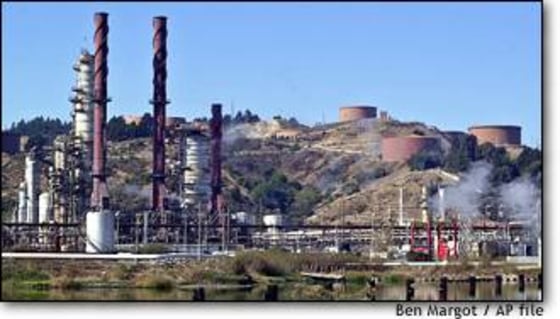A research team reported Thursday that they’ve discovered a way to nearly eliminate sulfur from fuel — a clean-air technology that could be applied to refineries and vehicles in a few years, and then to fuel cells in the future. Working with the National Science Foundation and an oil company, the team still has work to do but hopes to commercialize the process within three years.
The reduction in sulfur was “orders of magnitude higher” than previous results using a technique whereby sulfur compounds are removed by attaching certain chemicals to them, the team wrote in the new issue of the journal Science.
The findings are important because sulfur dioxide contributes to respiratory illness, aggravates existing heart and lung diseases, helps create acid rain and reduces visibility.
Sulfur dioxide is formed when fuel containing sulfur is burned. While not the only pollutant from vehicles and industry, sulfur dioxide is one of six tightly regulated by the Environmental Protection Agency.
In the Science article, the University of Michigan chemical engineers said they found a class of chemicals, known as zeolites, that do the job better of removing sulfur compounds than any other chemicals used so far in a search that dates back 50 years.
In a test on diesel fuel, the team found, “the sulfur content was reduced from 430 to less than .2 parts per million by weight.”
That drop is well below what industry will be required to comply with in the next few years: reductions of sulfur in diesel from the current average of 500 parts per million by weight to 15 ppm, and in gasoline from the current 350 ppm to 30 ppm.
BETTER THAN CATALYTIC PROCESS
The researchers also noted that the technique, known as adsorption, is done at room temperature and pressure. Currently, refiners, power plants and vehicles use catalytic converters operating at high temperature and pressure to remove sulfur and other pollutants from gasoline, diesel and jet fuel.
The researchers noted that some petroleum refiners “are seriously considering reducing or eliminating production of transportation fuels” because of the severely high costs of compliance.
On the other hand, adsorption could lead to “major advances in petroleum refining as well as for fuel cell applications,” the team wrote.
Ralph Yang, one of the three researchers, said the technique has caught the attention of the Energy Department and industry. “We are working with an oil company now on this,” he said.
But he also cautioned that “a lot more engineering work has to be done,” adding that he hoped the process could be ready to help industry meet the sulfur deadlines in 2005 and 2006.
FUEL CELL CONNECTION
Removing sulfur is also a key step in the use of fuel cells to power vehicles and buildings. Unless pure hydrogen is extracted from solar or wind energy, a fossil fuel like gasoline must be used. But the sulfur in fossil fuels can damage the fuel cells themselves, and the new process could provide a way around that.
“To avoid poisoning the catalysts for the fuel processor and those in the electrode of the fuel cell, the sulfur concentration should preferably be below 0.1 to 0.2 ppm,” the team wrote.
Patrick Davis, an official at the U.S. Energy Department’s Office of Hydrogen, Fuel Cells and Infrastructure Technologies, agreed, noting that “desulfurization technologies will be important” in developing fuel cells.
“For transportation applications, I do not believe removing significant amounts of sulfur will be possible onboard the vehicle,” he added. “Therefore, excellent technologies for sulfur removal are needed for refineries” and future fuel “reformers” at service stations.
